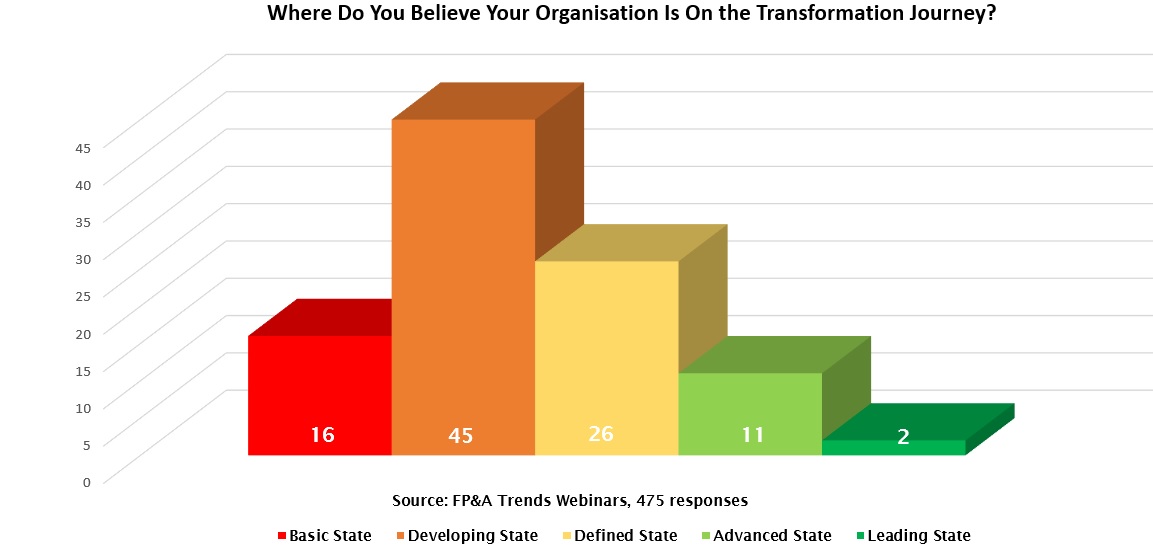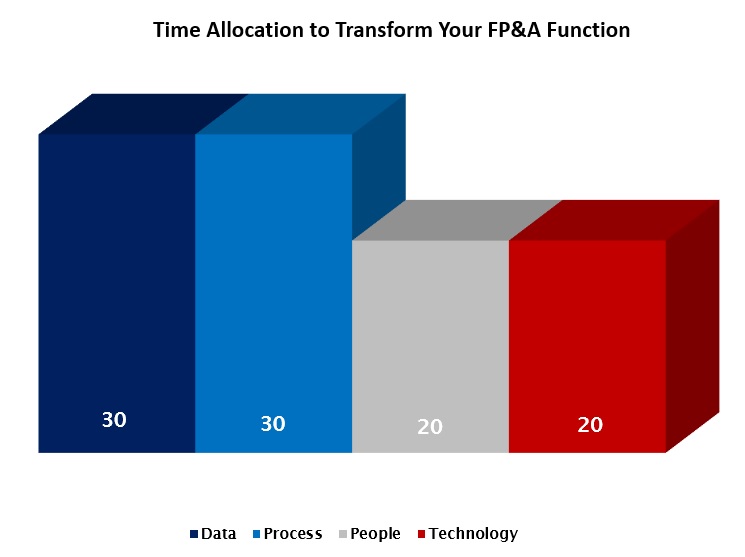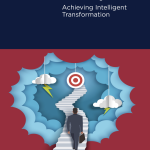In this article, we will explore the impact of digital transformation on FP&A and discuss how...
Of the many definitions of "FP&A Digital Transformation", this one fits the best:
"Changing focus from a less optimal state of execution to an ideal state of value creation. Achieved by transforming key FP&A Processes, technologies, and people."
This definition is the heart of what "FP&A Digital Transformation" looks like. It also happens to be where the challenges are.

Figure 1
According to an FP&A Trends Group Poll*, 87% of companies have not reached an advanced or leading state of maturity in their FP&A function. It means that many companies have long planning cycles and use Excel as their main tool. Some use automation like Power Query, SQL and VBA, but even fewer use Machine Learning. The percentage is high because there is no clear formula for success yet.
Why are companies getting it wrong? This article explores why modern technology alone is not enough to help with transformation while offering a mental model approach to digital transformation.
Transformation Journey
It is worth starting with a reminder of the purpose of the FP&A function: to help the business deliver on its strategy.
FP&A can only do this if there is a clear alignment with leadership for the strategic vision. If this is clear, FP&A can harness modern technology to create a harmonised financial and operational plan.
Everything Starts with Strategy
The main reason companies are getting digital transformation wrong is a lack of a clear success strategy. Defining a clear success strategy minimises the probability of failure. But what does this clear success strategy look like?
Begin with this mental model:
Company Y is in "State A" right now. What does this state look like? What are the key challenges in this state that will stop the business from reaching "State B"? What does "State B" even look like?
Most companies start by pushing for a "State B" with minimal consideration of "State A". The thought process is that implementing modern technology will magically transform the business and skyrocket its capabilities. It leads to failure.
Practical Example
A "State A" company could be one in a manual and, therefore, developing state. It uses tools that are manual and requires an extra headcount to use these tools, and as a result, the processes are complex. Complex processes are a clear blocker for reaching "State B". "State B" for this company is when its processes are simple, automated, and supported by quality data infrastructures. It can overlay modern BI tools to leverage its now optimised "State B", thus focusing on value creation through Business Partnering.
The "Feud" Between Leadership, Finance, and Business Operating Units
The FP&A function sometimes experiences a lack of trust from the rest of the business. To overcome this challenge, other functions have to understand that FP&A provides useful insights to sales and product teams. These insights help teams understand where they can optimise, and over time, this builds trust. These teams know the business better, so where is the value proposition?
FP&A is not here to take over from what operations know and do best. It is here to provide quality insights so that operations can raise the bar on their execution of the strategic plan. FP&A has been doing this for the last 10+ years. It has achieved this in large part through centralisation of forecasting and reporting. This has allowed business units to focus on running their unit, with FP&A serving as their Business Partners. Digital transformation will skyrocket the scale and impact of this.
The Need for Transformation
There has never been more demand for digital transformation. The COVID-19 pandemic has forced businesses to reassess everything. Working has switched to remote, and it's vital that the impact on BAU is minimal and that teams remain productive. FP&A teams spend a significant proportion of time being data engineers. Digital transformation enables teams to shift focus to value-creation activities and Business Partnering.
So, how does a business start?

Figure 2
Figure 2 illustrates how an FP&A Function can divide its time. As a guide, assume it takes 3 months to transform an FP&A Function from a basic state to a mature digital state. Figure 2 demonstrates that 2 months (60%) should be spent on redesigning data structures and FP&A Processes. 1 month (40%) should be spent on finding the right in-house/external tech solution to support the new data and processes, as well as on training people to operate in this new environment.
Mental Model on How to Approach a Digital Transformation
4 key focus areas operate in parallel: Data, Process, Technology, and People. They are mutual, and cross-functional project management should be set up.
- Data
Think about how to structure datasets. Is it optimised for storage and access?
- Process
Review existing FP&A Processes. How can the team optimise them in parallel with new data structures? Think of the wins, such as the automation of manual tasks. If the new data structures, in combination with the tech solution, allow the team to automate manual processes, the consensus should be to implement.
- Technology
Will an in-house or external tech solution fit best for the organisation? What are the requirements for the tech? To know this, a team can create a "current state" vs. a "desired state" document. It will highlight the gap and then an appropriate solution fit against that.
- People
Run a skills gap analysis. Define training programs to upskill people from existing to matured states. This is an opportunity to grow the team whilst optimising resource capacity and capabilities.
Let's Talk About Data and Its Quality for a Minute
Everyone knows garbage in = garbage out, right? The same applies to insights. It's not worth investing in tech solutions if the data is garbage. Therefore, there is a higher weighting (30%) for data compared to technology (20%). A team would fail instantly if its first attempt at transformation were to buy a tech solution and implement it without consideration of its existing data problems, processes, and people skills.
Modern technology built on top of a well-designed infrastructure helps skyrocket the quality of the insights FP&A can offer. Therefore, the digital transformation journey is not just about the technology; it's about the harmonisation between data, people, and processes alongside the modern technology that allows teams to harness its capabilities.
Even the best modern visualisation tool is worthless if the underlying data and processes are garbage.
Conclusion
The COVID-19 pandemic has forced companies to change the question from "Should we transform?" to "When and how do we transform?".
Larger corporations have an advantage - they can do this in-house and at scale. Most large corporations executed it and implemented it safely. The companies that got hit hardest relied 100% on on-site infrastructures.
The FP&A digital transformation is not limited to FP&A... it touches the whole organisation, which must transform in unison.
Let us end with a question.
Modern technology will help FP&A with digital transformation. How will modern technology transform the people who use it? Are you ready to transform?
This article was first published on the Wolters Kluwer blog.
Subscribe to
FP&A Trends Digest

We will regularly update you on the latest trends and developments in FP&A. Take the opportunity to have articles written by finance thought leaders delivered directly to your inbox; watch compelling webinars; connect with like-minded professionals; and become a part of our global community.






